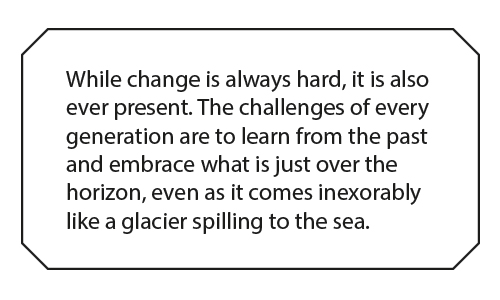Education, Alaska and Change – Drive Time Reflections
By Lisa Skiles Parady, JD, Ed.D.
Leaving my home near Skater’s Cabin in Juneau for work last week, I was thinking about wild Alaska. Glaciers and bears, bald eagles and rainforest, spectacular mountains rolling endlessly to the horizon all surrounded me – just another day in the Last Frontier. I was enjoying a quiet moment of reflection before the pace of phone calls, emails, texts, and tweets overtook my soon to be legislatively dominated day.
It hit me that our education system across this truly wild state is on the cusp of change almost as intense as what came with contact and settlement, yet we struggle to find the time to think, plan, and lead the change. I use the term “settlement” here loosely as I am confident Alaska Natives believe contact was way more significant.
Our challenges include flat funding, vast distances with logistics beyond outsiders’ ability to comprehend, and the complex cultural terrain of our first Alaskans and more recent immigrants, to name but a few.
While absorbed by these challenges, I was contemplating the basics – a strong teacher in a classroom, cheeks in the seats, the traditional (in the context of contemporary America) education model of the agrarian calendar, yet in a modern technological world. And I thought beyond today to the kinds of education it is going to take to thrive tomorrow.
Technology is profoundly changing education, yet education (the transmission of knowledge and values to the young) still has the same purpose as it did in Socrates time, as it did in a Qargi full of young Iñupiat on the bluffs above the Chukchi Sea, as it did in the original one-room schoolhouses that we romantically remember in the mists (or myths) of a Jeffersonian past.
While change is always hard, it is also ever present. The challenges of every generation are to learn from the past and embrace what is just over the horizon, even as it comes inexorably like a glacier spilling to the sea.
We can’t do what we’ve always done, but we have to map the steps in between as we transition to new ways to ‘do’ education. Trending nationally, especially from techies, is ‘disrupting education.’ But we are guardians of the young, and our duty is not just to disrupt, but to provide stability and leadership in our education systems in order to lead change.

Education is fascinatingly complex. Policymakers want to lead us into the future but they shackle us with the models of the past, their constant calls for accountability elevating compliance to a new level and making record keeping and reporting more and more a part of teachers’ lives.
It is not that teachers don’t want accountability; it is that they also need the freedom to deal with what is right in front of them – their students and their vibrant curiosity, their thirst for the new and the modern. Our educators are confronted with a variety of challenges that affects their students. Some are ready to learn while others struggle with homelessness, hunger, poverty, trauma, and other factors beyond the control of schools that make learning more difficult. In response to this, teachers’ jobs have changed from purely teaching reading, mathematics, and science to improving the life of each and every child.
To get where we need to go, everyone has to be engaged. I don’t wonder why we have trouble attracting people to education; I marvel that we attract the talent that we do. Is it the long hours, short pay, or thrilling work conditions? No. It is the students, and the chance to shape the future by growing young minds. I think about the communities I’ve lived in (Juneau, Utqiaġvik/Barrow, Laramie, Cody, Jackson – a cross section of Alaska and Wyoming, the true last frontiers), and how each student, family, teacher, and community has to take responsibility for students’ learning.
My morning drive buzz led me to look around, and when I got to work (in a brief unscheduled moment!) I found a fascinating article regarding education, innovation, and technology that fit the frame of ideas I had been spinning.
The article from the Brookings Institution (Winthrop and Shankar, 2016) was entitled The Top 5 Education Innovations Needed to Keep Up In a New Economy. I want to synthesize between my own ideas and theirs, and begin by noting that the purpose of education goes beyond employability to what it takes to be a citizen in a globalizing world.
Winthrop and Shankar’s thesis begins with the need to do something radical to transform education systems. The five top takeaways regard the role: (1) skills, (2) teachers, (3) technology, (4) non-state actors, and (5) accreditation play in supporting and delivering innovations in education. I want to focus on four of the five – to have fun with mixed metaphors, not the whole loaf but still a full meal deal!
1. “Education systems must work to expand and strengthen the education workforce.” This caught my eye, as I have been testifying before the Legislature regarding Alaska’s educator shortage crisis. The innovation they propose is based on what can be learned from the health sector, which has helped expand access to care by diversifying the roles of health workers. “Expanding the roles of teachers could enable them to become facilitators of learning rather than transmitters of content, or leverage community members to help unburden tasks” was a key thought, and technology tools can help. They suggest “[t]ools such as the Stanford Mobile Inquiry-based Learning Environment platform could also play a critical role in unburdening teachers by giving them options to easily engage and simultaneously assess students while encouraging critical thinking.” Districts’ emphasis on induction and professional development has never been more important. Not surprising, districts in Alaska that are giving the two priority are seeing increased teacher retention and better student performance.
2. “The application of technology to learning offers huge opportunities. From enhancing learning to improving data collection to driving down costs, technology can function across innovations. Examples like Can’t Wait to Learn show the massive potential of gamified tablets to reach students and help children acquire 21st century skills such as social and analytical skills. Other national platforms like KA Lite offer offline versions of Khan Academy to provide content where Internet access is limited.” The Teaching Channel has helped more than one thousand of Alaska’s teachers connect their professional learning efforts across their buildings, districts, and the state through the Alaska Professional Learning Network (AKPLN). A reality check – Alaska has the most challenging broadband environment in the United States!

Photo by Bridget Weiss © 2018
3. “Partnerships with non-state actors are critical for improving educational capacity.” We all know that education requires teamwork from a broad coalition, including districts, schools, NGO’s, health organizations, community groups, etc. We can all work together to wrap around students and build out our learners. Flexibility, alternative pathways, and choice (blended models) – while preserving quality learning – will be the new norm.
4. “Flexible accreditation systems are increasingly important. Ultimately, investments in alternative learning pathways like open educational resources such as massive open online courses must be supported by the entire environment to achieve results.” Here my inner rebel kicked in. We need to broaden approaches to skills verification. Why is a Carnegie Unit still defining a transcript in the second decade of the 21st Century? There are many ways to learn. We need to overhaul how we track student progress to adapt to the variable pathways to learning so that all of them count as growth. We need to be performance-based. Here in Alaska two performance-based districts long ago shed the constraints of age-based grade placement and have good results to show for it.

While we have the best jobs in the world, we have many challenges and many limits. But if we think about a teacher with their students, coupled with the tech tools at our fingertips, we have the chance to more fully understand each child, to help them take responsibility for their own learning, to truly personalize for each student based on their individual learning style, needs, and interests.
I want to close on a more sober note: Education can’t and shouldn’t look the same everywhere, yet is a large-scale system governed by lots of rules. As we think about how to change, we need to recognize that you can’t innovate when you can’t retain personnel, and you can’t change without the capacity to sustain that change. On my drive home that night, my thoughts again drifted to what could be and I smiled knowing that it was starting to happen.

Dr. Lisa Skiles Parady became the Executive Director of the Alaska Council of School Administrators in 2014. The Mission of ACSA is: Leadership, Unity and Advocacy for Public Education.
Before moving to Alaska, she served as Chief of Staff in the Wyoming Department of Education, as Director of the Wyoming Department of Workforce Services, and as Senior Policy Analyst in the Governor’s office responsible for all K-12 education, higher education, health and social service issues. Dr. Parady holds a Juris Doctorate and a Doctorate in Education Leadership and Administration.
Dr. Lisa Skiles Parady
Executive Director
Alaska Council of School Administrators